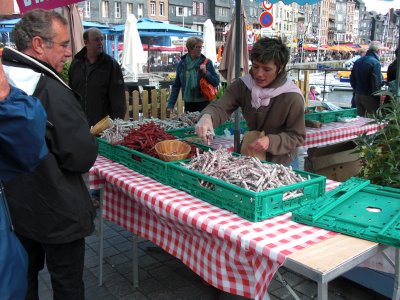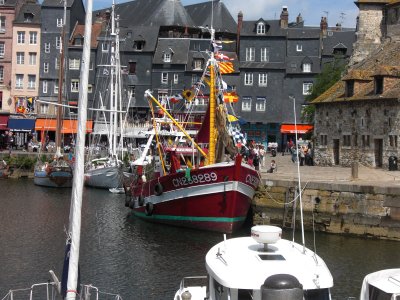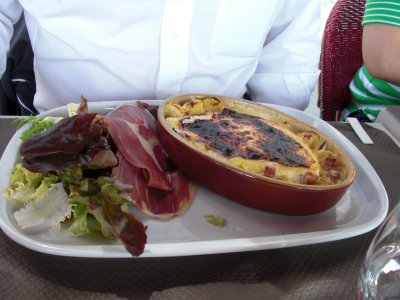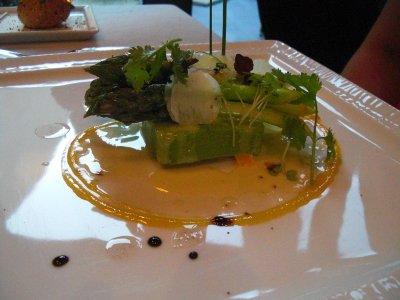Saturday, 16 June 2012: Le Havre to Caen, via Honfleur
Written 30 June 2012
After breakfast at the hotel, we set off for our next stop, Caen, but because everyone kept recommending it, we planned to stop for lunch in Honfleur, supposed to be one of be one of the prettiest towns in France (the impressionists certainly thought so). Closer to Caen, I also wanted to stop at the Banneville-la-Campagne war cemetery, where I had promised to photograph a grave for a friend who had never been able to visit it.
The first leg of the trip led back across a section of the port and then south over the Pont de Normandie, a huge, graceful, modern suspension bridge that joins the peninsula Le Havre occupies to the larger peninsula of the rest of lower Normandy.

 Honfleur certainly did live up to its reputation for picturesquity. In addition, it was market day, so the place was teeming and parking spaces hard to come by. Walking back to the middle of town from our parking space, we passed this memorial to Honfleur's war dead. Not only is the number awfully high for a town that size, but we saw dismayingly many runs of the same last name, appearing five or six times in the alphabetical list. As is usual in France, the main list is for WWI. The WWII names were added later, on the lower panel, below the level on which the cock stands.
Honfleur certainly did live up to its reputation for picturesquity. In addition, it was market day, so the place was teeming and parking spaces hard to come by. Walking back to the middle of town from our parking space, we passed this memorial to Honfleur's war dead. Not only is the number awfully high for a town that size, but we saw dismayingly many runs of the same last name, appearing five or six times in the alphabetical list. As is usual in France, the main list is for WWI. The WWII names were added later, on the lower panel, below the level on which the cock stands.
The market, already breaking up when we arrived, seemed to consist mainly of clothes, but a few stands were offering food. This lady is selling what are considered "cocktail sausages" in France, hard and dry, some dusted with the characteristic mold that grows on dry-cured sausages.

 This little red boat seemed to be trying especially hard to be picturesque. The building to the right of it, with the brownish gables is the famous "Lieutenance," the residence of the king's lieutenance, in charge of the port, which apparently every impressionist had to paint at least once (somebody was painting it while we were there, but I don't know whether he was an impressionist). Note how dark-colored the houses behind the red boat are. They have continued the slate of their rooves right down over their façades, as had many of the houses in the town. Speaks volumes about the weather around here.
This little red boat seemed to be trying especially hard to be picturesque. The building to the right of it, with the brownish gables is the famous "Lieutenance," the residence of the king's lieutenance, in charge of the port, which apparently every impressionist had to paint at least once (somebody was painting it while we were there, but I don't know whether he was an impressionist). Note how dark-colored the houses behind the red boat are. They have continued the slate of their rooves right down over their façades, as had many of the houses in the town. Speaks volumes about the weather around here.
At the right is a different view of it (the red boat is out of the frame to the left in the right-hand photo), with David and CJ for scale. As you can see, we got a few minutes of sun just then.

 For lunch, we settled at La Trinquette (just out of the left side of the photo of the red boat, on the far side of the harbor). David ordered a "tartifflette," thinking he would get (as we once did in the wilds of Burgundy) a salad with a square of tartifflette on top, but no, he got the full-bore item—a casserole dish in which a layer of sliced, cooked potato was covered with a layer of lardons and then a thick layer of Reblochon cheese and baked until bubbly. Just in case he should still be peckish, they added some sliced country ham on the side. (I learned during our 2009 visit to Burgundy that the tartifflette was invented in the 1980s, as a marketing ploy, by the makers of Reblochon, but I only learned this year, while reading a wonderful book on the history of food fears that I purchased on that trip, that "tartiffle" is an old French word for potato, cognate with "truffle.")
For lunch, we settled at La Trinquette (just out of the left side of the photo of the red boat, on the far side of the harbor). David ordered a "tartifflette," thinking he would get (as we once did in the wilds of Burgundy) a salad with a square of tartifflette on top, but no, he got the full-bore item—a casserole dish in which a layer of sliced, cooked potato was covered with a layer of lardons and then a thick layer of Reblochon cheese and baked until bubbly. Just in case he should still be peckish, they added some sliced country ham on the side. (I learned during our 2009 visit to Burgundy that the tartifflette was invented in the 1980s, as a marketing ploy, by the makers of Reblochon, but I only learned this year, while reading a wonderful book on the history of food fears that I purchased on that trip, that "tartiffle" is an old French word for potato, cognate with "truffle.")
CJ had another bacon omelet.

 I was delighted to be able to order "bulots mayonnaise," which you can't get just anywhere—a plate of (in this case) 19 fat little whelks, boiled and chilled and served with a mustardy home-made mayo. You peel the operculum off each one, then extract it from its shell with a skinny little two-tined fork with provided for the purpose, dip it in the mayo, and munch it right down. I love them. (And this time, every shell contained a whelk and nothing else; no hapless boiled hermit crabs in this batch.)
I was delighted to be able to order "bulots mayonnaise," which you can't get just anywhere—a plate of (in this case) 19 fat little whelks, boiled and chilled and served with a mustardy home-made mayo. You peel the operculum off each one, then extract it from its shell with a skinny little two-tined fork with provided for the purpose, dip it in the mayo, and munch it right down. I love them. (And this time, every shell contained a whelk and nothing else; no hapless boiled hermit crabs in this batch.)
While David and CJ had coffee in elegant conical glass cups, I indulged myself with a "coupe iceberg"—mint-chocolate-chip ice cream topped with whipped cream and "Get" mint liqueur. This one was a rather restrained version; it didn't even come topped with a paper parasol.

 Back on the road to Caen, we passed many picturesque buildings, including the Trouville Casino (left) and this lovely house (right).
Back on the road to Caen, we passed many picturesque buildings, including the Trouville Casino (left) and this lovely house (right).
We also found the Banneville cemetery, about 10 miles east of Caen, just where the Google map said it would be, and took a number of photos of it and of Donald Harvey's grave. I present those on a separate, dedicated page that you can reach by clicking either "next extry" below or here.
In Caen, we found the Hôtel Astrid easily enough, despite the maze of one-way streets, but it provided no parking or even anywhere to pull over to unload luggage. We circled the block a few times and finally pulled into the parking garage under the Monoprix department store. From there, we could trundle our luggage a couple of blocks to the hotel, but it was Saturday, and a prominent sign warned that the garage closed at 8 p.m. on Saturday night and did not reopen until 9:00 a.m. on Monday! Because we planned to drive to the evening's restaurant anyway, we were in no danger of having the car locked in, but we'd have to make other arrangements when we came back. Fortunately, at that hour, parking on the street was much easier.

 Our first restaurant in Caen was Ivan Vautier (GM 3/5).
Our first restaurant in Caen was Ivan Vautier (GM 3/5).
First amuse-bouche: Cheese shortbread cookies with something piped on top. Croquettes of foie gras on sticks, and some sort of savory macaroons. As you may have noticed, the French have, in the last few years, gone absolutely nuts over macaroons. They are everywhere, and they come in every imaginable flavor as well as a number that I could not have imagined.
Second amuse-bouche: A little strip of raw salmon rolled up with Savora (a brand of mustard) inside, a tomato gaspacho with a little tuna salad on top (served in one of those tiny glass jars that single-serve jams come in on breakfast buffets, and a beet sorbet flavored with piments d'Espelette (special Basque chile peppers).

 Both David and CJ raved about this first course, which was billed as an asparagus tart. At the very bottom, under all the other stuff, was apparently a thin base of crisp pastry. On top of that was the rectangular block of green vegetable mousse, in turn topped with spears of local asparagus (from a named supplier) and garnished with thin round disks of Parmesan cheese. The sauce around the bottom was orange- and cardamom-flavored.
Both David and CJ raved about this first course, which was billed as an asparagus tart. At the very bottom, under all the other stuff, was apparently a thin base of crisp pastry. On top of that was the rectangular block of green vegetable mousse, in turn topped with spears of local asparagus (from a named supplier) and garnished with thin round disks of Parmesan cheese. The sauce around the bottom was orange- and cardamom-flavored.
Meanwhile, I was enjoying my own starter, billed as "Belles de Noirmoutier" (special local new potatoes) topped with, in order, squares of (very lightly) smoked eel, quenelles of horseradish whipped cream, dabs of excellent caviar, and zucchini sprouts (a new sprout flavor for me, but very juicy and tasty).

 Main course, David: Veal cooked at low temperature accompanied by icicle radishes stewed slowly with lemon and ginger. The black quenelles are chopped olives, and the thick disk standing on edge is "marrow" (actually smooth, thick, rich purée) of celery root, sliced and rolled in pistachios.
Main course, David: Veal cooked at low temperature accompanied by icicle radishes stewed slowly with lemon and ginger. The black quenelles are chopped olives, and the thick disk standing on edge is "marrow" (actually smooth, thick, rich purée) of celery root, sliced and rolled in pistachios.
Main course, CJ: Scallop of line-caught bar (sea bass) roasted and served with a "deconstructed pissaladière." A pissaladière is a Proven&ecedil;al pizza of onion, olives, and anchovies. Top to bottom, the accompaniments are a compressed disk of braised onion topped by a roasted garlic clove, a quenelle of chopped olives, a smaller quenelle of anchovy purée, and a spot of cherry tomato purée (on more of which the fish is sitting).

 Main course, me: Veal sweetbreads "glazed in the skillet" with truffle and pistachio jus, and more of the celery-root stuff. The crispy cylindrical objects are langoustine tails wrapped in "feuilles de brik" (ultrathin Moroccan pastry leaves) and fried until crisp.
Main course, me: Veal sweetbreads "glazed in the skillet" with truffle and pistachio jus, and more of the celery-root stuff. The crispy cylindrical objects are langoustine tails wrapped in "feuilles de brik" (ultrathin Moroccan pastry leaves) and fried until crisp.
Predessert: A little verrine of gariguette strawberries topped with, of all things, a mousse of basmati rice. An excellent combination!
Dessert, all of us: Olive-oil shortbread cookies, each topped with apricot compote, then with a cylinder of milk-and-olive-oil mousse (a little too stiff; more like marshmallow), then a think cookie. Lavender ice cream on the side.
This was, in some ways, a very odd dinner. The food was very good, certainly up to its rating, but the wait staff were uniformly from the moon! They didn't seem very knowledgeable about the food (not good, at this level of establishment), their timing was ragged, and it was like being waited on by the Addams Family! When I referred to one waiter as Lurch and another as Peter Lorre, the others both knew just who I meant. Uncle Fester was actually female.
The little interior courtyard that formed the view from our table seemed very zen—fine white pebbles punctuated by a circle of larger ones, a little bonzai-like potted spruce, other pot bearing succulents, clumps of fine, wiry grass—until night fell. Then a small fountain erupted from the center of the circle of larger pebbles, and can lights hidden in the pebbles illuminated everything strategically. At that point, it seemed much more Disney than zen; layers of engineering were clearly hidden below the surface.
previous entry
List of Entries
next entry

 Honfleur certainly did live up to its reputation for picturesquity. In addition, it was market day, so the place was teeming and parking spaces hard to come by. Walking back to the middle of town from our parking space, we passed this memorial to Honfleur's war dead. Not only is the number awfully high for a town that size, but we saw dismayingly many runs of the same last name, appearing five or six times in the alphabetical list. As is usual in France, the main list is for WWI. The WWII names were added later, on the lower panel, below the level on which the cock stands.
Honfleur certainly did live up to its reputation for picturesquity. In addition, it was market day, so the place was teeming and parking spaces hard to come by. Walking back to the middle of town from our parking space, we passed this memorial to Honfleur's war dead. Not only is the number awfully high for a town that size, but we saw dismayingly many runs of the same last name, appearing five or six times in the alphabetical list. As is usual in France, the main list is for WWI. The WWII names were added later, on the lower panel, below the level on which the cock stands.
 This little red boat seemed to be trying especially hard to be picturesque. The building to the right of it, with the brownish gables is the famous "Lieutenance," the residence of the king's lieutenance, in charge of the port, which apparently every impressionist had to paint at least once (somebody was painting it while we were there, but I don't know whether he was an impressionist). Note how dark-colored the houses behind the red boat are. They have continued the slate of their rooves right down over their façades, as had many of the houses in the town. Speaks volumes about the weather around here.
This little red boat seemed to be trying especially hard to be picturesque. The building to the right of it, with the brownish gables is the famous "Lieutenance," the residence of the king's lieutenance, in charge of the port, which apparently every impressionist had to paint at least once (somebody was painting it while we were there, but I don't know whether he was an impressionist). Note how dark-colored the houses behind the red boat are. They have continued the slate of their rooves right down over their façades, as had many of the houses in the town. Speaks volumes about the weather around here.
 For lunch, we settled at La Trinquette (just out of the left side of the photo of the red boat, on the far side of the harbor). David ordered a "tartifflette," thinking he would get (as we once did in the wilds of Burgundy) a salad with a square of tartifflette on top, but no, he got the full-bore item—a casserole dish in which a layer of sliced, cooked potato was covered with a layer of lardons and then a thick layer of Reblochon cheese and baked until bubbly. Just in case he should still be peckish, they added some sliced country ham on the side. (I learned during our 2009 visit to Burgundy that the tartifflette was invented in the 1980s, as a marketing ploy, by the makers of Reblochon, but I only learned this year, while reading a wonderful book on the history of food fears that I purchased on that trip, that "tartiffle" is an old French word for potato, cognate with "truffle.")
For lunch, we settled at La Trinquette (just out of the left side of the photo of the red boat, on the far side of the harbor). David ordered a "tartifflette," thinking he would get (as we once did in the wilds of Burgundy) a salad with a square of tartifflette on top, but no, he got the full-bore item—a casserole dish in which a layer of sliced, cooked potato was covered with a layer of lardons and then a thick layer of Reblochon cheese and baked until bubbly. Just in case he should still be peckish, they added some sliced country ham on the side. (I learned during our 2009 visit to Burgundy that the tartifflette was invented in the 1980s, as a marketing ploy, by the makers of Reblochon, but I only learned this year, while reading a wonderful book on the history of food fears that I purchased on that trip, that "tartiffle" is an old French word for potato, cognate with "truffle.")
 Back on the road to Caen, we passed many picturesque buildings, including the Trouville Casino (left) and this lovely house (right).
Back on the road to Caen, we passed many picturesque buildings, including the Trouville Casino (left) and this lovely house (right).
 Our first restaurant in Caen was Ivan Vautier (GM 3/5).
Our first restaurant in Caen was Ivan Vautier (GM 3/5). 
 Both David and CJ raved about this first course, which was billed as an asparagus tart. At the very bottom, under all the other stuff, was apparently a thin base of crisp pastry. On top of that was the rectangular block of green vegetable mousse, in turn topped with spears of local asparagus (from a named supplier) and garnished with thin round disks of Parmesan cheese. The sauce around the bottom was orange- and cardamom-flavored.
Both David and CJ raved about this first course, which was billed as an asparagus tart. At the very bottom, under all the other stuff, was apparently a thin base of crisp pastry. On top of that was the rectangular block of green vegetable mousse, in turn topped with spears of local asparagus (from a named supplier) and garnished with thin round disks of Parmesan cheese. The sauce around the bottom was orange- and cardamom-flavored.
 Main course, David: Veal cooked at low temperature accompanied by icicle radishes stewed slowly with lemon and ginger. The black quenelles are chopped olives, and the thick disk standing on edge is "marrow" (actually smooth, thick, rich purée) of celery root, sliced and rolled in pistachios.
Main course, David: Veal cooked at low temperature accompanied by icicle radishes stewed slowly with lemon and ginger. The black quenelles are chopped olives, and the thick disk standing on edge is "marrow" (actually smooth, thick, rich purée) of celery root, sliced and rolled in pistachios.
 Main course, me: Veal sweetbreads "glazed in the skillet" with truffle and pistachio jus, and more of the celery-root stuff. The crispy cylindrical objects are langoustine tails wrapped in "feuilles de brik" (ultrathin Moroccan pastry leaves) and fried until crisp.
Main course, me: Veal sweetbreads "glazed in the skillet" with truffle and pistachio jus, and more of the celery-root stuff. The crispy cylindrical objects are langoustine tails wrapped in "feuilles de brik" (ultrathin Moroccan pastry leaves) and fried until crisp.